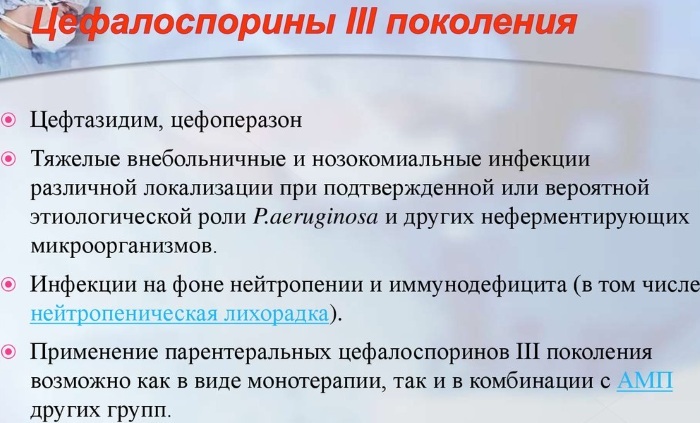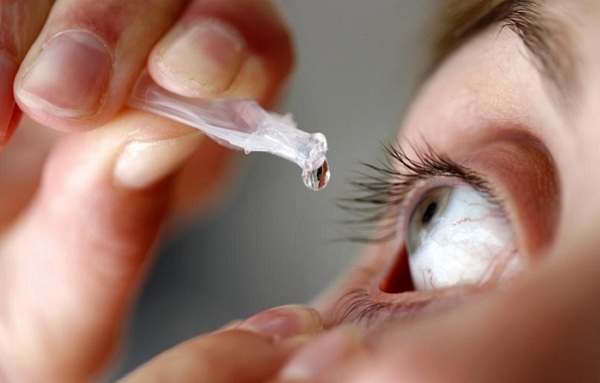TO broad-spectrum antibiotics refers to the drug Ampiox in tablets, which contains ampicillin and oxacillin. The drug helps to cope with gram-positive and gram-negative pathogens.
The maximum therapeutic effect is achieved if the drug is taken on an empty stomach. The active components of the antibiotic help to cope with infectious and inflammatory diseases.
The drug has a wide spectrum of action, but before use it is necessary to consult with your doctor in order to exclude the likelihood of adverse reactions. The slightly overpriced antibiotic is justified by its effectiveness in the treatment of bronchitis, tonsillitis and bacterial pneumonia.
Record content:
- 1 Release form and composition of the drug
- 2 Pharmacological properties
- 3 Pharmacodynamics and pharmacokinetics
- 4 Indications for use
- 5 Contraindications
- 6 At what age can the drug be used?
- 7 Instructions for use, dosage
- 8 Side effects
- 9 Overdose
- 10 special instructions
- 11 Drug interactions
- 12 Analogs
- 13 Terms, conditions of sale and storage
- 14 Price
- 15 Video about analogs of Ampiox
Release form and composition of the drug
Ampiox tablets (the price of the drug allows you to use it for a long time to fight inflammatory diseases, which affect the organs of the urinary tract and the gastrointestinal tract) for oral use is sold in blisters according to 10 pieces.
1 tablet contains 0.25 g of a mixture of ampicillin trihydrate and oxacillin sodium salt (in a 1: 1 ratio).
The preparation contains the following auxiliary components:
- Sucrose.
- Magnesium stearate.
- Primellose.
- Potato starch.
- Talc.
Additionally, the drug Ampiox is available in dark glass jars, each of which contains 20 tablets.
Pharmacological properties
Ampiox tablets belong to the category of affordable combination antibiotics that are used to relieve inflammation and improve the patient's condition.
The high efficiency of the drug is due to the presence of two active components in the composition:
- Oxacillin. It is a semi-synthetic antibiotic from the penicillin group. Oxacillin has a bactericidal effect against gram-positive microorganisms and gram-negative cocci.
-
Ampicillin. It is an effective semi-synthetic substance from the category of penicillins, which exhibit high acid resistance and also have bactericidal properties. Ampicillin is active against gram-positive and gram-negative microorganisms.

The advantage of the drug is that the active ingredients do not accumulate upon repeated use. In the annotation to Ampiox, the manufacturer indicated that this drug is a synthetic antibiotic of the beta-lactam series. The action of the drug is aimed at a significant increase in the synthesis of the cell membrane.
When used correctly, the medication helps to fight the following pathogens:
- Pneumococci.
- Staphylococci.
- Streptococci.
- Gonococci.
- Meningococci.
- Salmonella sticks.
- Shigella.
- Influenza.
- Escherichia coli.
Before using the antibiotic, the patient must undergo a comprehensive examination of the body so that the attending physician can correctly determine the diagnosis and prescribe an effective treatment regimen.
Pharmacodynamics and pharmacokinetics
The components of the drug quickly enter the systemic circulation from the gastrointestinal tract. The bioavailability of Ampiox increases significantly if the medicine is taken on an empty stomach. The maximum concentration of the drug in the blood plasma is reached after 60 minutes. after using the pill.
The positive therapeutic effect of the drug lasts for 6 hours. The half-life of the drug from the body is 6-9 hours. If the patient is diagnosed with anuria, then the components of the drug remain in the body for 10-20 hours. Ampiox is excreted thanks to the kidneys. The drug does not accumulate in the tissues of internal organs.
Indications for use
Ampiox tablets (the price is primarily of interest to patients who have been prescribed long-term treatment of secondarily infected dermatoses, impetigo and other diseases of soft tissues or skin) can only be prescribed by a qualified doctor after collection anamnesis.
An effective broad-spectrum antibiotic is prescribed for the treatment of the following diseases:
- Chronic and acute bronchitis.
- Erysipelas.
- Unclassified bacterial meningitis.
- Chronic sinusitis.
- Otitis media.
- Pneumonia.
- Impetigo.
- Unclassified bacterial meningitis.
- Cholecystitis.
- Agranulocytic tonsillitis.
- Cholangitis (inflammation of the bile ducts due to the penetration of infection into them).
- Urethritis, urethral syndrome (inflammation of the urethra).
- Pyelonephritis.
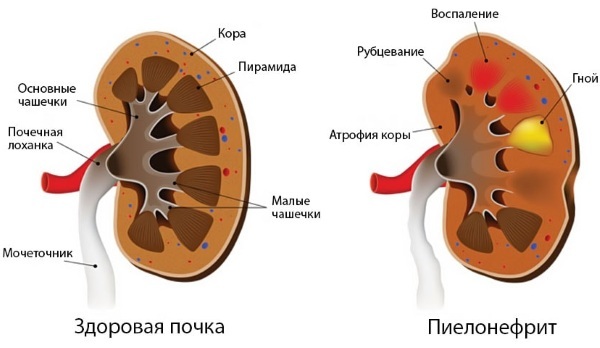
- Cystitis.
- Chronic and acute tubulointerstitial nephritis (development of an inflammatory process in the renal tubules and interstitial tissue).
- Pyelitis.
- Septicemia.
- Inflammatory diseases of the cervix.
- Postpartum sepsis.
- Acute endocarditis.
- Kidney infections.
- Burn disease.
- Acute sinusitis.
- Local infection of the subcutaneous tissue and skin.
- Gonococcal infection.
In traditional medicine, Ampiox is in great demand, since with the help of this medicine it is possible to prevent the development of purulent-septic complications after a surgical operation. The drug is used in pediatrics for the prevention and treatment of infectious diseases in newborns.
Contraindications
Before using the antibiotic Ampiox, the patient should study the annotation attached to it. An effective treatment regimen can only be prescribed by a qualified doctor, since the dosage of the drug depends on the form of the diagnosed disease.
To reduce the likelihood of adverse reactions, you must take into account the following contraindications to the use of the medication:
- Lymphocytic leukemia.
- Infectious mononucleosis.
- Hypersensitivity to the components of the drug.
- Chronic renal failure.
- Children's age (up to 3 years old).
The expediency of prescribing Ampiox to a patient during pregnancy can only be assessed by a qualified gynecologist. If the drug will be used during lactation, then it is recommended to refuse breastfeeding for the duration of treatment.
At what age can the drug be used?
Ampiox tablets (the price of the antibiotic is justified by its effectiveness in the fight against infections in newborns) is used in pediatrics to treat children over 3 years old. Only a pediatrician can determine a dosage of a drug that is safe for a child.
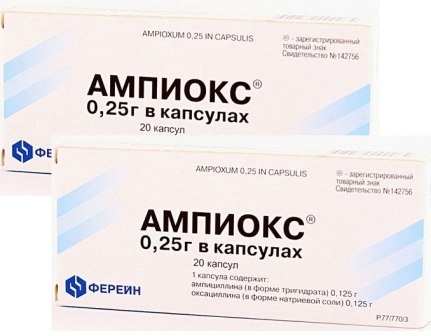
To reduce the likelihood of side effects, experts recommend using 10 mg of the drug per 1 kg of body weight of a child whose age ranges from 3 to 7 years. For the treatment of children from 7 to 14 years old, the dosage of the antibiotic should be within 50 mg / kg of the patient's weight.
Instructions for use, dosage
To combat gram-positive and gram-negative microorganisms, the drug Ampiox is recommended to be taken according to the general scheme. An individual course of treatment can only be prescribed by the attending physician after a comprehensive examination of the patient's body and taking an anamnesis.
A single dosage of the drug Ampiox for adults and children over 14 years old is 2-4 g. The maximum daily dose of the antibiotic should not exceed 4 g. A standard therapeutic course is designed for 1-2 weeks.
To achieve the maximum therapeutic effect, the manufacturer of the drug recommends dividing the daily dose of the drug into 5-6 doses. It is forbidden to independently increase the dosage of the drug, as this is fraught with the development of concomitant pathologies.
Side effects
Ampiox in tablets (the price, indications and contraindications for the use of the antibiotic should be studied by the patients who are prescribed drug treatment of infectious lesions of the lung tissue and respiratory tract) in isolated cases provokes the occurrence allergic reaction. It is accompanied by an increase in body temperature and anaphylactic shock.
The annotation to the drug indicates that its constituent components can cause the following side reactions:
- Rhinitis.
- Nausea, vomiting.
- Stool disorder.
- Conjunctivitis.
- Change in taste.
- Angioedema.
- Pseudomembranous enterocolitis.
- Hyperemia of the skin.
- Hives.

- Anemia.
- Chills.
- Neutropenia (a decrease in neutrophilic granulocytes in the total cellular composition of the blood to a level of less than 1500 / μl).
- Arthralgia.
- Leukopenia.
- Eosinophilia.
- Anaphylactic shock.
- Infiltrate.
- Dysbacteriosis.
- Periphlebitis.
If side effects occur, the attending physician may prescribe desensitizing agents to the patient, which reduce the likelihood of an acute allergic reaction. At the first manifestations of anaphylactic shock, emergency measures should be taken. For example, you need to take antihistamines or glucocorticosteroids.
If the patient has clear signs of the development of a secondary disease, then it is necessary to consult with your doctor and undergo a comprehensive examination to confirm or deny the presence of superinfection.
A rapid deterioration in the patient's well-being is possible when pathogenic strains of bacteria that are insensitive to ampicillin enter the body. To achieve a positive therapeutic effect, the doctor makes changes to the previously prescribed treatment regimen.
During treatment, the patient should refuse to stay in the open sun in order to reduce the likelihood of developing photosensitivity (increased sensitivity of the body to bright light).
If the patient's intake of an antibiotic provoked a stool disorder, then a comprehensive examination of the organisms is necessary so that the doctor can exclude pseudomembranous enterocolitis. If the disease is confirmed, then further use of Ampiox must be abandoned.
Overdose
In the annotation to the drug, the manufacturer indicated that a significant excess of the recommended dosage of the antibiotic Ampiox can have a toxic effect on the functioning of the central nervous system.
Failure to comply with the treatment regimen prescribed by the doctor is fraught with the following overdose symptoms:
- Increased sweating.
- Vomiting, development of dyspeptic disorders.
- Flatulence.
- An increase in the concentration of bilirubin in the blood.
- Aching pain in the epigastric region.
- Urticaria, Quincke's edema, anaphylactic shock.

- Anemia.
- Muscle weakness.
- Aching headache.
- Increased fatigue.
- Sleep disturbance.
In medicine, there is no special antidote for an overdose of the drug Ampiox. To reduce the likelihood of a rapid deterioration in the patient's well-being, qualified medical care is needed. Only after examining the patient will the doctor be able to prescribe an effective symptomatic therapy.
special instructions
Throughout the entire course of treatment with the drug Ampiox, it is necessary to monitor the work of the hematopoietic organs, liver and kidneys.
Due to the rapid growth of antibiotic insensitive pathogens, there is a high probability the development of superinfection, which implies that the attending physician makes appropriate amendments to the prescribed antibacterial treatment.
Experts admit the development of cross-allergic reactions to cephalosporin antibiotics, which is associated with an increased sensitivity of the patient to drugs of the penicillin group. The occurrence of anaphylactic shock requires urgent action.
In severe cases, the patient may need artificial ventilation. The final absorption indicators of Ampiox are significantly increased by ascorbic acid, and reduced by food products, antacids and laxative medications.
Drug interactions
Combined drug therapy can only be prescribed by the attending physician who has previously studied the patient's history and correctly identified the diagnosis.
In the instructions for the drug Ampiox, the manufacturer indicated the following information on drug interactions:
- Bacteriostatic drugs have an antagonistic effect. For example, sulfonamides, tetracyclines, macrolides, Chloramphenicol, lincosamides.
- Antibiotics of the bactericidal principle of action have a synergistic effect.
- Laxatives, aminoglycosides and antacids significantly slow down and reduce the absorption of Ampiox.
- If indirect anticoagulants are included in the complex therapy, then their effectiveness will increase significantly due to the components of Ampiox. This effect is achieved due to the suppression of the intestinal microflora, a decrease in the prothrombin index and the synthesis of vitamin K.
- It is forbidden to take Ampiox simultaneously with oral contraceptives and medications, in the process of metabolism of which para-aminobenzoic acid is formed. Otherwise, the effectiveness of therapy will be significantly reduced, and the likelihood of developing internal bleeding will also increase.
- Phenylbutazone, non-steroidal drugs, Probenecid and diuretics in combination with Ampiox reduce the final tubular secretion, due to which the concentration of the antibiotic in the blood plasma increases, which increases the risk of toxic effects of drugs on the body the patient.
- The likelihood of rashes on the skin increases significantly if you take an antibiotic with Allopurinol.
Combined drug therapy will be effective only if the patient's attending physician takes into account the drug interactions of all drugs involved. Otherwise, the patient's condition can rapidly deteriorate against the background of the development of concomitant pathologies.
Analogs
If there are contraindications to the use of Ampiox, it must be replaced with a safer drug. Several effective medicines are presented on the pharmaceutical market at once that help to cope with gram-positive and gram-negative microorganisms.
| Drug name | Description |
| Graximol | This medication is prescribed for the treatment of respiratory tract infections: otitis media, tonsillitis, bronchitis, sinusitis, pharyngeal abscess, pneumonia, pharyngitis. Graximol has the following contraindications: infectious mononucleosis, hypersensitivity to drug components, lymphocytic leukemia, cholestatic jaundice. The drug is recommended to be taken with caution in case of pseudomembranous colitis, renal failure, as well as in chronic pathologies of the gastrointestinal tract. The standard dosage for adults is 3 scoops of suspension (5 ml) 2 times a day. The duration of the therapeutic course is determined by the attending physician. The standard treatment is for 7-14 days. |
| Ospamox |
 The drug is prescribed for bacterial infections that were provoked by pathogens that are sensitive to penicillin antibiotics. The drug helps to overcome the following diseases: pharyngitis, otitis media, bronchitis, laryngitis. Ospamox is prescribed before bacteriological testing. The drug should not be used in the presence of the following diseases: lymphocytic leukemia, allergic diathesis, bronchial asthma, respiratory viral infections, hay fever. With oral administration of the drug, a single dosage for adults and children over 10 years old should be in the range of 250-500 mg. In severe cases, the dosage can be increased to 1 g. The drug is prescribed for bacterial infections that were provoked by pathogens that are sensitive to penicillin antibiotics. The drug helps to overcome the following diseases: pharyngitis, otitis media, bronchitis, laryngitis. Ospamox is prescribed before bacteriological testing. The drug should not be used in the presence of the following diseases: lymphocytic leukemia, allergic diathesis, bronchial asthma, respiratory viral infections, hay fever. With oral administration of the drug, a single dosage for adults and children over 10 years old should be in the range of 250-500 mg. In severe cases, the dosage can be increased to 1 g. |
| Flemoxin Solutab | This drug is recommended to be included in the composition of monotherapy, and also taken in combination with clavulanic acid when infections of the gastrointestinal tract, diseases of the skin and soft tissues, gynecological pathologies. Flemoxin Solutab is forbidden to use for allergic diathesis, lymphocytic leukemia, bronchial asthma, hypersensitivity to penicillins. Adults and children over 10 years old should take 250-500 mg of the drug once a day. The maximum daily dosage is 1 g. For the treatment of acute gonorrhea, 3 g of the drug should be taken once in combination with Probenecid. The duration of treatment depends on the diagnosed disease and the patient's condition. |
| Amoxicillin Forte | This drug is prescribed for the treatment of infections of the respiratory, genitourinary and biliary tract. The drug must not be used in the presence of the following diseases and conditions: hypersensitivity organism to the components of the drug, lymphocytic leukemia, infectious mononucleosis, cholestatic jaundice. Adults and children weighing more than 45 kg are prescribed 1500-3000 mg / day. This dose of the drug must be divided into 4 doses. The permissible daily dosage of the drug is 6000 mg. The duration of the therapeutic course is determined individually. |
| Oxamp |
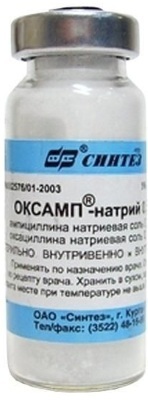 The drug is used to treat the following diseases: bronchiectasis, sinusitis, bronchitis, tonsillitis, otitis media middle ear, pleurisy, salmonellosis, endocarditis, meningitis, impetigo, burn disease, prevention of postoperative complications. The drug is used to treat the following diseases: bronchiectasis, sinusitis, bronchitis, tonsillitis, otitis media middle ear, pleurisy, salmonellosis, endocarditis, meningitis, impetigo, burn disease, prevention of postoperative complications.Oxamp is not prescribed for lymphocytic leukemia, infectious mononucleosis, individual sensitivity of the body to the constituent components. To achieve a positive therapeutic effect, you need to divide the daily dosage (0.5-1 g) of the drug into 4-6 doses. Treatment should last 5 to 14 days. |
In medical practice, for oral administration, instead of Ampiox, Ospin, Augmentin, Flemoxin and Oxacillin are often used. Before buying a medication, you need to study the instructions attached to it to make sure there are no contraindications.
Terms, conditions of sale and storage
The antibiotic Ampiox is sold only by prescription. It is recommended to store the drug in a well-ventilated, dry place out of direct sunlight. The air temperature in the room should be between +5 and +25 C. The shelf life of the drug is 2 years from the date of release, which is indicated on the package. After this period, the unused medicine must be disposed of.
Price
You can buy the drug Ampiox in tablets at any pharmacy. The price of the drug varies from 120 to 350 rubles. The cost of an antibiotic largely depends on the region of residence and the markup of the selected pharmacy network.
Video about analogs of Ampiox
About Amoxicillin:

